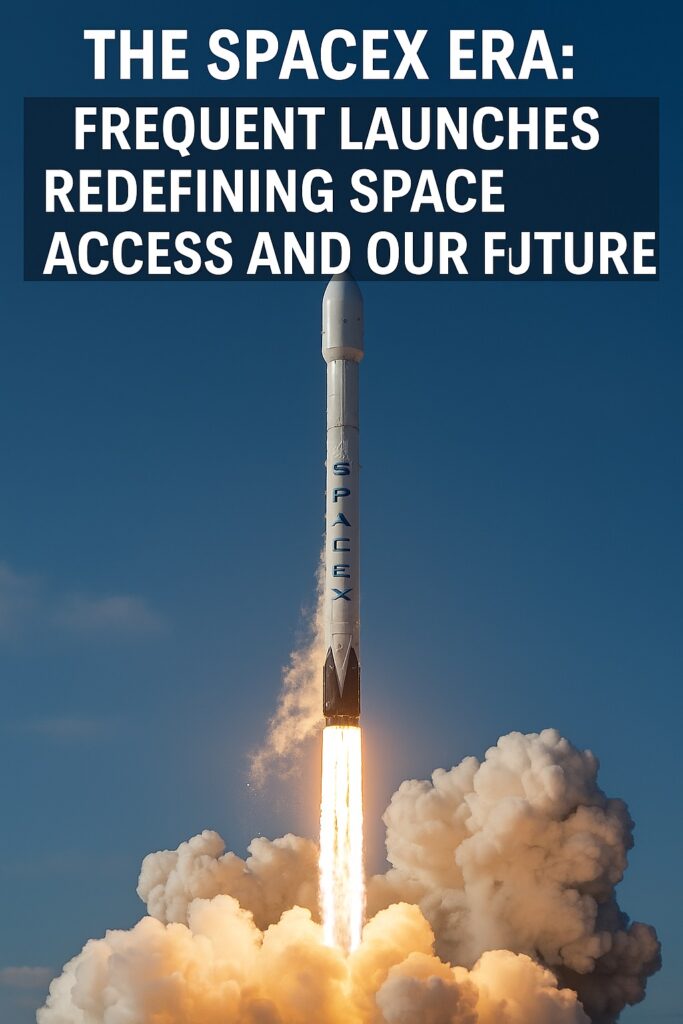
A New Normal: Rockets That Fly Weekly
Not long ago, a rocket launch was a historic event, broadcast live and watched with awe. Today, thanks to SpaceX, it has become almost routine. In 2024 alone, the company completed over 90 successful launches, and 2025 is on track to exceed that pace. This dramatic increase is not just about volume—it’s about transformation. SpaceX is rewriting the rules of the space industry, introducing frequent, affordable access to orbit, and laying the groundwork for our future among the stars.
1. The Launch Cadence Revolution: More Launches, Lower Costs
1.1 Rapid Reusability
The key to SpaceX’s high launch frequency lies in its reusable rockets. The Falcon 9 booster, in particular, has revolutionized orbital access. Some boosters have flown up to 20 times—a record that would have been unthinkable just a decade ago. The ability to recover and relaunch within days dramatically increases throughput while slashing costs. (Source)
1.2 Cost Reduction
Reusable technology has driven down costs significantly. According to SpaceX, the cost of launching a Falcon 9 can be under $30 million—far lower than traditional expendable rockets. This affordability has opened the door for startups, universities, and developing nations to access space.
1.3 Impact on Satellite Industry
The lower costs have enabled massive satellite constellations, especially Starlink, and accelerated the smallsat boom. Companies and governments are no longer limited by budgetary constraints in reaching orbit.
2. Starlink: Connecting the Globe from Orbit
2.1 Global Internet Connectivity
Starlink, SpaceX’s satellite internet project, aims to provide high-speed, low-latency internet to even the most remote regions. As of mid-2025, over 6,000 satellites are in orbit, with thousands more planned. (Source)
2.2 Real-World Applications
From enabling internet in disaster-hit areas to powering communications in war zones, maritime operations, and rural education, Starlink’s applications are rapidly growing. Airlines like Hawaiian and military units in Ukraine have adopted the service. (Source)
2.3 Future Expansion
SpaceX is now preparing to deploy its second-generation Starlink satellites via the massive Starship rocket, increasing bandwidth and reliability, and expanding coverage to new regions.
3. Starship: Humanity’s Ticket to the Moon and Beyond
3.1 Vision and Capabilities
Starship represents the cornerstone of Elon Musk’s vision to make humanity multi-planetary. Designed to carry over 100 tons to orbit and support lunar and Mars missions, Starship is the largest and most powerful rocket ever built. (Source)
3.2 Testing and Development
SpaceX continues iterative development at Starbase, Texas. While some test flights have ended in explosions, they’ve also delivered crucial data. The latest test in May 2025 successfully achieved orbital velocity and soft water landing—signaling major progress. (Source)
3.3 Key Missions Ahead
Starship is central to NASA’s Artemis program as the Human Landing System for lunar missions. Beyond that, Musk envisions fleets of Starships heading to Mars within the next decade. (Source)
4. Beyond the Launches: Broader Impacts and Challenges
4.1 Competitive Landscape
SpaceX’s aggressive innovation has forced legacy providers like ULA and Arianespace, and newcomers like Blue Origin, to adapt. Governments are now investing in reusable launch systems to compete. (Source)
4.2 Space Debris Concerns
With thousands of satellites in orbit, concerns about orbital debris have intensified. SpaceX claims its satellites are designed to de-orbit at end-of-life and has proposed active debris mitigation strategies. (Source)
4.3 Regulatory and Geopolitical Factors
Operating a global satellite network brings legal and diplomatic hurdles. Spectrum allocation, national licensing, and geopolitical tensions are key challenges SpaceX must navigate. (Source)
Conclusion: The SpaceX Era Has Arrived
From redefining launch economics to connecting the globe and enabling deep space exploration, SpaceX has ushered in a new era. Its rapid launch cadence, Starlink’s global internet promise, and the audacious goals of Starship are reshaping our relationship with space. As humanity sets its sights on the Moon, Mars, and beyond, SpaceX stands at the frontier.
🙋♂️ About the Author
Sandeep is a passionate technology and aerospace writer. While not a certified expert, he closely follows private space companies and global agencies to provide grounded, accessible insights into humanity’s expanding frontier.
Article Published Date: June 17, 2025









